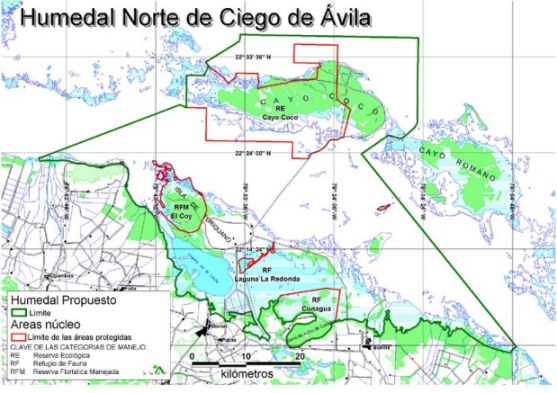Cuba names five new Ramsar sites

The Bureau of the Ramsar Convention is delighted to announce that the Government of Cuba has designated five extraordinarily valuable wetlands for the List of Wetlands of International Importance, bringing that country's total surface area under the Ramsar umbrella to 1,188,411 hectares. These five sites include an impressive array of coastal wetland types and provide support for many species of flora and fauna, some of them rare or endangered. The very commendable efforts by Cuban authorities to designate these new sites have been materially assisted by WWF's Living Waters Programme. The new Ramsar sites are --
Buenavista. 18/11/02. Villa Clara, Sancti Spiritus. 313,500 ha. 22º27'N, 078º49'W. National Park, Protected Area, UNESCO Biosphere Reserve. Located in Cuba's central region, Buenavista is made up of various coastal and continental wetland types, including extensive beaches and dune systems, coastal lagoons, mangroves and karst. The karstic mound formations in Buenavista Bay are unique within the Cuban archipelago. The site boasts important flora and fauna, as well as areas of high archeological, speleological, and cultural value. Currently, there are no human settlements within the wetland, which is protected under different conservation schemes, but various economic activities take place in the area, among them commercial and sports fishing, forestry, cattle farming and tourism. Conservation efforts are centered on regulating these activities, as well as on improving management capacity of the site. Ramsar site no. 1133.
Ciénaga de Lanier y Sur de la Isla de la Juventud. 18/11/02. Isla de la Juventud. 126,200 ha. 21º36'N, 082º48'W. Managed Resource Protected Area (IUCN Category VI). Occupies the southern part of the Isla de la Juventud, including the Ciénaga de Lanier marshland. The site, located in the second largest island of the Cuban archipelago includes diverse biotopes, among them semi-deciduous forests, reef lagoons, marine grasslands, mangroves and peatlands. Within the Caribbean, the site is a truly unique mosaic of ecosystems - amongst them a karstic plain connected to the island's southern coast. This subterranean drainage system yields clear waters that favor the formation of coral reefs. A number of threatened species are present in the site, including green turtles (Chelonia mydas), loggerheads (Caretta caretta), and American crocodiles (Crocodylus acutus). The region possesses a high number of endemic plant species, and constitutes an important nesting site for various chelonian, amphibian, crustacean and fish species. The main threats to the site include forest fires, the future increase of tourism activities in the area, and the possible effects of climate change. Ramsar site no. 1134.
Gran Humedal del Norte de Ciego de Ávila. 18/11/02. Ciego de Ávila. 226,875 ha. 22º19'N, 078º29'W. Six Protected Areas within site. Occupies the northern part of the Ciego de Ávila province, spanning most of its coast, its immediate maritime zone, and adjacent islets. This wetland includes two unique coastal water reservoirs, Lagunas de la Leche and La Redonda, which feed the area's subterranean basins. The main vegetation types around the lagoons include marsh forests, marsh grasslands, and mangroves. The site is inhabited by large waterbird populations of greater flamingos (Phoenicopterus ruber) and double-crested cormorants (Phalacrocorax auritus), as well as other more rare species such as darters (Anhinga anhinga) and West Indian whistling ducks (Dendrocygna arborea). The site's rich marine platform provides abundant fishing resources, while its scenic beauty has made it the country's third largest tourism area. Ramsar site no. 1235.
Humedal Delta del Cauto. 18/11/02. Granma, Las Tunas. 47,836 ha. 20º34'N, 077º12'W. Two Protected Areas within site. The largest delta in Cuba and one of the most important in the Caribbean, the Humedal Delta del Cauto is an intricate system of estuaries, lagoons, marshes and swamps of singular beauty. Its inaccessibility and difficulty of transit have kept anthropic effects to a minimum at the site. The local flora includes some of the best preserved mangrove populations (four species) in Cuba, as well as several species of Copernicia. Several vulnerable and endangered animal species inhabit the site, among them the endemic Cuban parakeet (Aratinga euops), Cuban tree-duck (Dendrocygna arborea) and Birama anole (Anolis birama). This wetland is also considered a major contributor to the productiveness (fisheries) of the Gulf of Guacanayabo, where the Río Cauto flows out to the sea. Ramsar site no. 1236.
Humedal Río Máximo-Cagüey. 18/11/02. Camagüey. 22,000 ha. 21º43'N, 077º27'W. Protected Area. An extremely fragile marine-coastal ecosystem undergoing salinization, this wetland is located at the mouth of the rivers Máximo and Cagüey, and includes a number of keys located in the shallow surroundings. The area is the largest nesting site for flamingos (Phoenicopterus ruber ruber) in all the Caribbean and the Antilles, and it's also a refuge for other migratory birds from North, Central and South America. Large populations of American crocodile (Crocodylus acutus) and Caribbean manatee (Trichechus manatus manatus), both vulnerable species, inhabit the site. The dominant vegetation types in the area include mono-dominant and mixed mangrove forests, microphyllic and swamp evergreen forests, and Conocarpus erectrus and Bucida spp. evergreen forests. Adverse factors affecting the site are related to human activities in the catchment area, including upstream deviations of the water supply and pollution from agricultural residual waters. Ramsar site no. 1237.

-- reported by Julio Montes de Oca, Ramsar